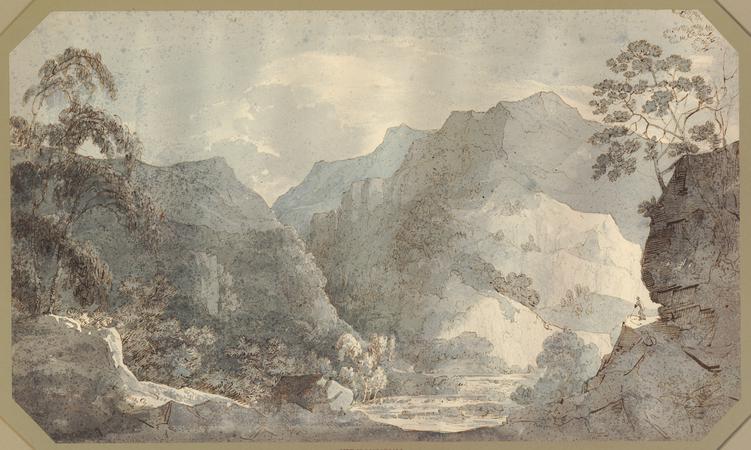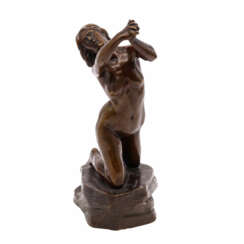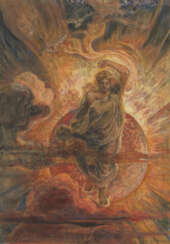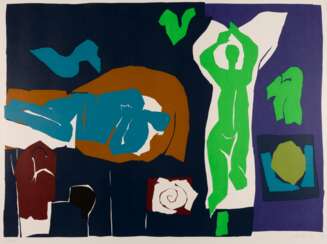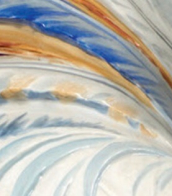stock

Georg Daniel Stocker was a German sculptor who worked with bronze. He was a student at the Art Academy in Stuttgart under Adolf von Donndorf. His younger brother was the sculptor Rudolf Stocker (1879-1949).


Henry John Stock was a British Pre-Raphaelite painter and representative of the English Romantic tradition.
Henry was nearly blind as a child, but gained his sight when he went to live at Beaulieu in the New Forest. Fully recovered, he attended St. Martin's School of Art and the Royal Academy schools. And apparently the trials of his childhood played a role in the artist's outlook. Stock enjoyed success as a secular portraitist, but his main area of interest has always been fantasy, religious and mythological subjects.


Henry John Stock was a British Pre-Raphaelite painter and representative of the English Romantic tradition.
Henry was nearly blind as a child, but gained his sight when he went to live at Beaulieu in the New Forest. Fully recovered, he attended St. Martin's School of Art and the Royal Academy schools. And apparently the trials of his childhood played a role in the artist's outlook. Stock enjoyed success as a secular portraitist, but his main area of interest has always been fantasy, religious and mythological subjects.


Henry John Stock was a British Pre-Raphaelite painter and representative of the English Romantic tradition.
Henry was nearly blind as a child, but gained his sight when he went to live at Beaulieu in the New Forest. Fully recovered, he attended St. Martin's School of Art and the Royal Academy schools. And apparently the trials of his childhood played a role in the artist's outlook. Stock enjoyed success as a secular portraitist, but his main area of interest has always been fantasy, religious and mythological subjects.


Henry John Stock was a British Pre-Raphaelite painter and representative of the English Romantic tradition.
Henry was nearly blind as a child, but gained his sight when he went to live at Beaulieu in the New Forest. Fully recovered, he attended St. Martin's School of Art and the Royal Academy schools. And apparently the trials of his childhood played a role in the artist's outlook. Stock enjoyed success as a secular portraitist, but his main area of interest has always been fantasy, religious and mythological subjects.


Henry John Stock was a British Pre-Raphaelite painter and representative of the English Romantic tradition.
Henry was nearly blind as a child, but gained his sight when he went to live at Beaulieu in the New Forest. Fully recovered, he attended St. Martin's School of Art and the Royal Academy schools. And apparently the trials of his childhood played a role in the artist's outlook. Stock enjoyed success as a secular portraitist, but his main area of interest has always been fantasy, religious and mythological subjects.


Henry John Stock was a British Pre-Raphaelite painter and representative of the English Romantic tradition.
Henry was nearly blind as a child, but gained his sight when he went to live at Beaulieu in the New Forest. Fully recovered, he attended St. Martin's School of Art and the Royal Academy schools. And apparently the trials of his childhood played a role in the artist's outlook. Stock enjoyed success as a secular portraitist, but his main area of interest has always been fantasy, religious and mythological subjects.


Henry John Stock was a British Pre-Raphaelite painter and representative of the English Romantic tradition.
Henry was nearly blind as a child, but gained his sight when he went to live at Beaulieu in the New Forest. Fully recovered, he attended St. Martin's School of Art and the Royal Academy schools. And apparently the trials of his childhood played a role in the artist's outlook. Stock enjoyed success as a secular portraitist, but his main area of interest has always been fantasy, religious and mythological subjects.




Gabriele Stock-Schmilinsky was a German painter and art school director.
In the 1930s, Gabriele Stock-Schmilinsky went on study trips to Paris and Italy with her friend Eduard Bargheer. Artistically influenced initially by Expressionism, she became increasingly involved with Cubism and then Tachism from the 1950s onwards.


Henry John Stock was a British Pre-Raphaelite painter and representative of the English Romantic tradition.
Henry was nearly blind as a child, but gained his sight when he went to live at Beaulieu in the New Forest. Fully recovered, he attended St. Martin's School of Art and the Royal Academy schools. And apparently the trials of his childhood played a role in the artist's outlook. Stock enjoyed success as a secular portraitist, but his main area of interest has always been fantasy, religious and mythological subjects.


Carlotta Stocker is a Swiss expressionist artist, interior designer and illustrator. She is especially known for her large-scale interpretations of the studio table, in which she worked with strong colors. She developed an expressive, emotional and colorful style for her works. Stocker also created large-format murals in public buildings in Zurich.


Carlotta Stocker is a Swiss expressionist artist, interior designer and illustrator. She is especially known for her large-scale interpretations of the studio table, in which she worked with strong colors. She developed an expressive, emotional and colorful style for her works. Stocker also created large-format murals in public buildings in Zurich.
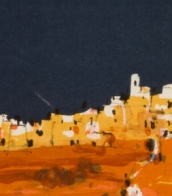

Carlotta Stocker is a Swiss expressionist artist, interior designer and illustrator. She is especially known for her large-scale interpretations of the studio table, in which she worked with strong colors. She developed an expressive, emotional and colorful style for her works. Stocker also created large-format murals in public buildings in Zurich.


Carlotta Stocker is a Swiss expressionist artist, interior designer and illustrator. She is especially known for her large-scale interpretations of the studio table, in which she worked with strong colors. She developed an expressive, emotional and colorful style for her works. Stocker also created large-format murals in public buildings in Zurich.


Carlotta Stocker is a Swiss expressionist artist, interior designer and illustrator. She is especially known for her large-scale interpretations of the studio table, in which she worked with strong colors. She developed an expressive, emotional and colorful style for her works. Stocker also created large-format murals in public buildings in Zurich.


Carlotta Stocker is a Swiss expressionist artist, interior designer and illustrator. She is especially known for her large-scale interpretations of the studio table, in which she worked with strong colors. She developed an expressive, emotional and colorful style for her works. Stocker also created large-format murals in public buildings in Zurich.


Carlotta Stocker is a Swiss expressionist artist, interior designer and illustrator. She is especially known for her large-scale interpretations of the studio table, in which she worked with strong colors. She developed an expressive, emotional and colorful style for her works. Stocker also created large-format murals in public buildings in Zurich.


Carlotta Stocker is a Swiss expressionist artist, interior designer and illustrator. She is especially known for her large-scale interpretations of the studio table, in which she worked with strong colors. She developed an expressive, emotional and colorful style for her works. Stocker also created large-format murals in public buildings in Zurich.


Carlotta Stocker is a Swiss expressionist artist, interior designer and illustrator. She is especially known for her large-scale interpretations of the studio table, in which she worked with strong colors. She developed an expressive, emotional and colorful style for her works. Stocker also created large-format murals in public buildings in Zurich.




Karlheinz Stockhausen was a German innovative and avant-garde composer, conductor, and musical theorist.
Stockhausen studied at the State Academy of Music in Cologne and the University of Cologne, then in 1952 in Paris with composers Olivier Messiaen and Darius Millau. Returning to Cologne in 1953, he joined the electronic music studio West German Broadcasting (Westdeutscher Rundfunk), of which he was artistic director from 1963 to 1977. Stockhausen created his first electronic music piece in 1953.
In the mid-1950s Stockhausen studied phonetics, acoustics and information theory at the University of Bonn, all of which he used in his musical compositions. From 1953 he began teaching composition in Darmstadt and later organized seminars in Cologne. From 1971 to 1977 he was already professor of composition at the State Academy of Music in Cologne.
Stockhausen used both electronic and traditional instrumentation and supported his approach with rigorous theoretical reasoning and radical innovations in musical notation. He ensured that sounds were equally interesting regardless of the order in which they appeared; random decisions of musical order play an important role in many of his compositions.
Stockhausen lectured and gave concerts with his works throughout Europe and North America. As a creator and theorist of electronic and serial music, he had a significant influence on avant-garde composers of the 1950s and 1980s.


Karlheinz Stockhausen was a German innovative and avant-garde composer, conductor, and musical theorist.
Stockhausen studied at the State Academy of Music in Cologne and the University of Cologne, then in 1952 in Paris with composers Olivier Messiaen and Darius Millau. Returning to Cologne in 1953, he joined the electronic music studio West German Broadcasting (Westdeutscher Rundfunk), of which he was artistic director from 1963 to 1977. Stockhausen created his first electronic music piece in 1953.
In the mid-1950s Stockhausen studied phonetics, acoustics and information theory at the University of Bonn, all of which he used in his musical compositions. From 1953 he began teaching composition in Darmstadt and later organized seminars in Cologne. From 1971 to 1977 he was already professor of composition at the State Academy of Music in Cologne.
Stockhausen used both electronic and traditional instrumentation and supported his approach with rigorous theoretical reasoning and radical innovations in musical notation. He ensured that sounds were equally interesting regardless of the order in which they appeared; random decisions of musical order play an important role in many of his compositions.
Stockhausen lectured and gave concerts with his works throughout Europe and North America. As a creator and theorist of electronic and serial music, he had a significant influence on avant-garde composers of the 1950s and 1980s.

